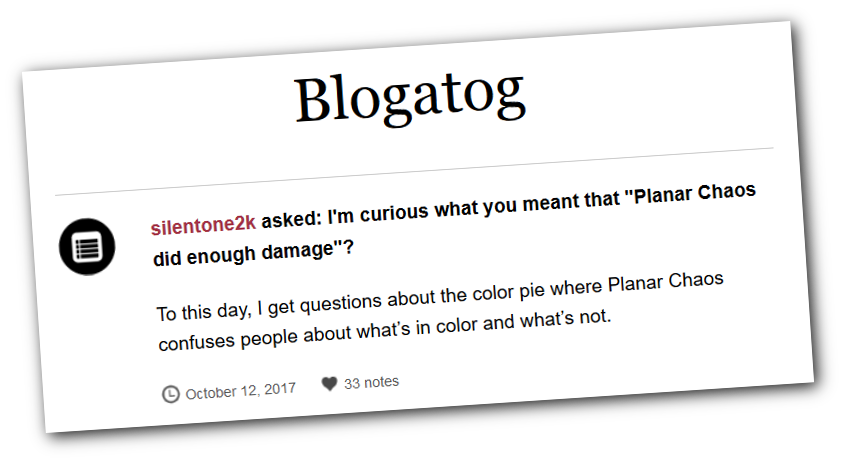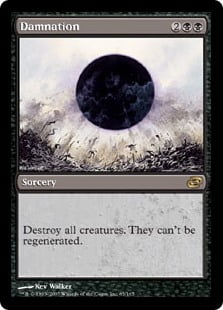Back when Planar Chaos came out I mostly said at the time that it was a fine opportunity for Wizards of the Coast to address its failings, and start setting a new hard precedent in what the game should be, citing the examples of Damnation and Prodigal Pyromancer as signs of what the game’s colours should feature. This perspective, broadly speaking is wrong because Planar Chaos wasn’t meant to be that. I was the one in the wrong, with my sensible-seeming but incorrect assumption.
As it turns out, I was not alone

It’d be pretty easy to just call Planar Chaos a series of mistakes, but it’s a mistake of a different kind to the sort that filter out of R&D. The mistakes of Urza’s Saga are failures of development and refinement, the ‘mistake’ of [mtg_card]Fires of Yavimaya[/mtg_card]/[mtg_card]Saproling Burst[/mtg_card] as a combo was a failure of pre-loading time, and so on. Most of the time, the failures are also pretty ludic: Players are presented with a system, and engage with that system in a way that selects for optimal play experiences. Environments become saturated with ‘best decks’ or draft formats grow stale as optimal strategies surface or combos speed up the game in general.
These are, broadly speaking, problems and mistakes that come up in the conventional tournament play of the game. But Planar Chaos is a mistake of the culture of the players, and a culture that was only going to come to head as social media and real, immediate interaction with the game developers became more of A Thing. As development of the game became more connected to the play environment and made more – reasonable! – concessions to the wider variety of players, there was a more centralised community of people who were interested in the game for its design sake. They even got an archetype name – Mel!
These are the players who, as a community, care about not what Magic will do, or does do, but about what it can do. What the rules permit, what the design space of the game could allow for, within the limitations of still being the game. Now there’s a sad illusion in the Mel group that because they care about rules, Mel players are largely dealing with objective information. This can mean Mel conversations wind up being rather about designing within parameters that R&D actually build within (which tend to be player-focused systems and rely on a lot of playtesting and human activity), they try to basically reduce human engagement with the game into math. These Mels, the ones who fall into this trap, are the lovers and fans of precedent.
Precedent in Magic: The Gathering is a dangerous thing, because we already know that it doesn’t work. We know that Alpha had bad balance. We know that Mercadian Masques wasn’t a great set. We know that Mirrodin-era standard had Problems. But yet, when you extract a card from its greater context, it’s often easy to forget that. Hey, Wizards printed Storm spells twice, we can revisit that mechanic without fear, right1.?
In this game of semi-objective reference-sniping, in the climbing of Mount Cleverest, there is one set that stands head and shoulders above all others as an example of Precedent That Is Definitely Not Precedent.

Planar Chaos was printed in 2007 as part of the insular2. Time Spiral Block. Amongst its cards was a smaller subset of cards that were ‘Planeshifted,’ cards from an alternate present of Magic: The Gathering, where cards that were once printed in one colour were re-flavoured to be printed in a different colour, if the flavour of the colour pie had been interpreted differently. This was a chance for Wizards to do some really big, splashy, impressive things, like-

yeah, that.
Now I’m not going to argue much about whether or not Damnation was right at the time. I personally see it now as a relic of when Wrath of God was the lynchpin of white power (whoah is that a phrase that feels bad) back in the day and when Day of Judgement took over and things opened up and became very different, and therefore, Damnation is just part of Modern and it sucks that Black has this in terms of how The Game Should Go, but hey, we’ve been moving away from Regeneration and anyway. Point is, Damnation isn’t a card that led to black getting global Destroy All since then.
Planeshifted cards also included [mtg_card]Prodigal Pyromancer[/mtg_card], a card that was then reprinted in a core set. I personally view that now in that Prodigal Pyromancer is from an alternate past where Wizards never made the mistake of Prodigal Sorcerer. That’s not how it works, but this is the problem: Planeshifted cards didn’t have a single, fixed, sensible and coherent interpretation for what they were. What’s more, Planar Chaos also featured cards that weren’t Planeshifted, but were also meant to be from this ‘alternative present’ – like [mtg_card]Needlepeak Spider[/mtg_card].
Now, mostly these cards vanished under the waves because for all that Planar Chaos was full of weird cards, most of them weren’t very good. Standard at this time was having a hard time dealing with very straightforward problem represented by [mtg_card]Teferi, Mage of Zhalfir[/mtg_card], a control card so ferociously strong that players were cutting counterspells they didn’t need any more, and a blue-base prison combo was standard legal in the form of ‘Pickles’ a deck that ran on [mtg_card]Vesuvan Shapeshifter[/mtg_card] and [mtg_card]Brine Elemental[/mtg_card]. [mtg_card]Aeon Chronicler[/mtg_card] jumped into these decks and there was a land destruction deck running around, but broadly speaking, Planar Chaos didn’t do much that anyone cared about. The enduring Planar Chaos cards have been reprinted, like [mtg_card]Urborg, Tomb of Yawgmoth[/mtg_card].
These cards were not going to be lasting influences on constructed formats – very few sets really are. Mostly it’s individual cards that have an impact, and in Planar Chaos, most of those weird cards don’t provide that impact. For the players who care about precedent in design, though? Planar Chaos is a hand grenade, it blows apart all sorts of assumptions about what Wizards would or wouldn’t do. It’s full of too-complex cards, cards that could be printed in a colour but shouldn’t be because they don’t provide useful tools or interesting play experiences compared to the cards that already exist in that set. There are not really any breaks, but there are some bends. I mean, it’s not like [mtg_card]Pyrohemia[/mtg_card] is as potent an effect as [mtg_card]Pestilence[/mtg_card] in a colour that lacks lifegain, card draw and mana expansion like [mtg_card]Cabal Coffers[/mtg_card].
Really, the fact is we should be ignoring Planar Chaos in its entirety. Any card that’s printed only in Planar Chaos isn’t a useful example for field of reference and should instead be evaluated not as a card Wizards made but as a card Wizards might make.
1. This was such a recurrent problem in the social media space around Wizards that the name of Mark Rosewater’s scale of not coming back to the game is literally The Storm Scale.
2. Insular in this case refers not to the mechanics but the motifs and themes of the set. More than any set before it or after it, the theme of Time Spiral block is Magic: The Gathering. It’s a set so full of references to other places it’s quite dizzying to dig into them – and often they’re not actually particularly clever, they just exist.